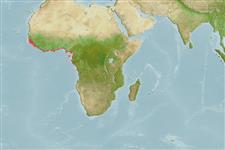Classification / Names
Common names from other countries
Main reference
Size / Weight / Age
Max length : 30.0 cm SL male/unsexed; (Ref. 27000); common length : 16.0 cm SL male/unsexed; (Ref. 188)
Length at first maturity
Lm 13.0, range 13 - 18 cm
Environment
Marine; brackish; pelagic-neritic; depth range 0 - 25 m (Ref. 26999)
Climate / Range
Tropical, preferred 27°C (Ref. 107945); 17°N - 7°S, 17°W - 14°E (Ref. 54448)
Distribution
Short description
Anal
spines: 0;
Anal
soft rays: 45 - 50. Diagnosis: Body moderately deep, compressed, belly with 25 to 27 + 7 or 8 sharp scutes (Ref. 188, 81270). Dorsal fin at or before midpoint of body; pelvic fins small; anal fin long, with more than 40 finrays, its origin below dorsal fin base (Ref. 188). Swimbladder with two short tubes passing back in the muscles on either side of haemal spines (Ref. 188). Other clupeoid fishes in the area are more slender, have a much shorter anal fin and the lower jaw is not strongly projecting (Ref. 188).
IUCN Red List Status (Ref. 115185)
Threat to humans
Harmless
Human uses
Fisheries: commercial
More information
ReferencesAquacultureAquaculture profileStrainsGeneticsAllele frequenciesHeritabilityDiseasesProcessingMass conversion
Tools
Special reports
Download XML
Internet sources
Estimates of some properties based on models
Phylogenetic diversity index
PD50 = 0.5000 many relatives (e.g. carps) 0.5 - 2.0 few relatives (e.g. lungfishes)
Trophic Level
3.6 ±0.2 se; Based on diet studies.
Resilience
High, minimum population doubling time less than 15 months (K=0.8-1.3)
Vulnerability
Low vulnerability (19 of 100)
Price category
